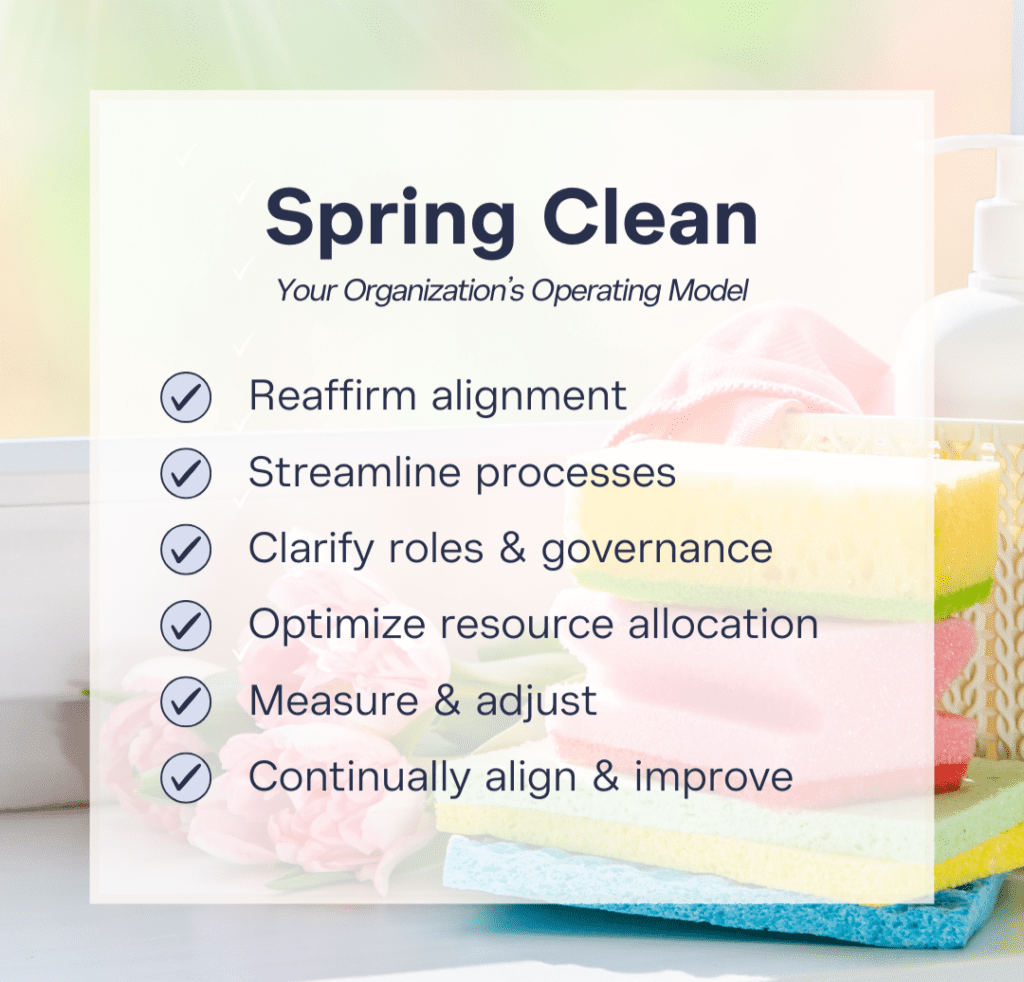As spring ushers in a season of renewal, it’s an opportune time for organizations to rejuvenate their operating models. Just as we declutter our homes, businesses can benefit from a “spring cleaning” to enhance efficiency, align with strategic goals and foster sustainable growth.
Drawing inspiration from AlignOrg Solutions’ methodologies, here are several key steps to revitalize your organization’s operating model:
1. Reaffirm Strategic Alignment
Begin by revisiting your organization’s strategic objectives. Ensure that your operating model—the way work is structured and executed—directly supports your goals. An effective operating model is the backbone of a successful organization. It helps ensure clarity and agility while enhancing decision-making and execution. Without alignment between strategy and operations, organizations risk inefficiency, confusion and stagnation. Review alignment periodically and adjust for changes to strategy, markets, personnel, financial results, competition and other factors.
2. Streamline Processes
Evaluate existing workflows to identify redundancies or bottlenecks. Streamlining processes enhances efficiency and responsiveness, boosts agility, improves sustainable growth and aligns operations with strategic objectives for maximum efficiency.
Seek to optimize how work is done, how decisions are made and how resources are allocated to execute strategy more effectively. Optimizing to achieve maximum efficiency empowers teams to act swiftly, brings changes to market quickly, maintains scalability and breaks down silos to enhance teamwork across functions.
3. Clarify Roles and Governance
Clear governance structures and role definitions prevent overlaps and confusion for leaders and team members alike. Eliminating ambiguity empowers teams to work more efficiently, helping allocate resources to better match organizational goals. Ensure that decision-making authorities are well-defined, that accountability mechanisms are in place and that roles are clearly communicated to each team member. This clarity fosters a cohesive and focused organizational effort while boosting performance and employee satisfaction. It also allows organizations to operate with greater precision and purpose.
4. Optimize Resource Allocation
Assess how resources—time, budget, talent—are distributed across projects and departments. Aligned organizations can better optimize their resources to create greater efficiencies and drive growth. By focusing on strategic capabilities and aligning resources accordingly, organizations can invest more effectively in areas that yield the highest returns. Taking a holistic approach aligns the entire organization, from strategy development all the way through implementation. Often, organizations with a less-than-perfect strategy outperform those with superior strategies because better aligned leaders move faster and make choices that ultimately bring higher growth and efficiency.
5. Measure and Adjust
Implement metrics to monitor the effectiveness of changes. Track specific objectives, such as market share, customer satisfaction and return on investment to clarify whether results are meeting specific strategic goals. Regularly review these indicators to ensure the operating model remains aligned with strategic objectives and is delivering desired outcomes. Be prepared to make adjustments as necessary.
Knowing what to track and why helps leaders better understand how organizational change is unfolding. It also highlights problems early so they can be addressed quickly. Taking a strategic approach to downsizing, for example, helps these organizations ensure they are cutting fat, not muscle. Leaders should look at each person or role to understand their strategic contributions before reducing headcount based on arbitrary criteria.
6. Foster a Culture of Continuous Alignment
Encourage a mindset where teams regularly assess and refine their approaches. Continuous alignment and improvement keeps the organization adaptable to market changes and internal shifts. Building a culture that supports these factors enables organizational learning and renewal while emphasizing ongoing efficiencies throughout the organization. AlignOrg’s Cube Model highlights the importance of ongoing evaluation to maintain a competitive edge. Regular reviews indicate how well organizational results are meeting your goals and objectives, and indicate changes that may still be needed.
Companies that have set up more robust business systems generally have a better handle on continuous alignment. Many companies operate in what we might call a “super-deep-cleaning and decluttering mode” on an irregular basis, and then go back to business as usual until the next realignment exercise. However, those with full-bodied systems think about realignment on a more frequent basis. This helps them identify and implement changes more rapidly. The latter companies become more effective by operationalizing alignment and making it part of their leaders’ DNA.

By embracing these “spring cleaning” steps, your organization can shed outdated practices, realign with its strategic vision and cultivate an environment primed for innovation and success.





